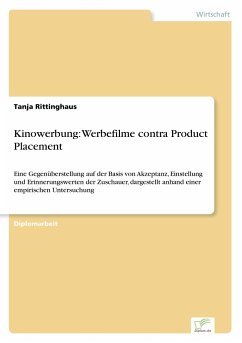Diploma Thesis from the year 1998 in the subject Business economics - Marketing, Corporate Communication, CRM, Market Research, Social Media, grade: 1,65, Catholic University of Applied Sciences Osnabrück (Unbekannt), language: English, abstract: Inhaltsangabe:Abstract:
The dissertation scrutinises the opportunities that product placement may entail as an additive and integral part of a company s marketing mix. It also discusses its imminent disadvantages and threats as posed by the relevant German legislation. The main focus, however, is placed on the conceivable effects of product placement as regards brand awareness, recall, attitudes and increasing turnover.
Einleitung:
Die Arbeit untersucht die Möglichkeiten, welche "Product Placement" als eine additive und integrierte Komponente des Marketing-Mixes für interessierte Unternehmen bietet. Weiterhin werden ökonomisch bedingte Nachteile und Einschränkungen im Rahmen der deutschen Gesetzgebung erläutert. Das Hauptaugenmerk jedoch liegt auf den möglichen Auswirkungen des Product Placements auf Markenbekanntheit, Recall, Einstellungen (Attitudes) und Umsatzsteigerungen.
Inhaltsverzeichnis:Table of Contents:
List of abbreviationsVII
0.Executive Summary1
1.Introduction and scope of this worK2
1.1Objectives and limitations2
1.2Method of approach3
1.3Definition of terms4
1.4Categorisation of Product Placement within the communications mix7
2.Reasons for the development and growth of Product Placement10
2.1Overview10
2.2General market conditions and how to react to them10
2.3The changing face of the electronic media market11
2.3.1Television11
2.3.2Cinema/The film industry13
2.3.3Video16
2.4Growing ineffectiveness of traditional forms of advertising17
2.4.1New forms of media usage as reactions to the information overload17
2.4.2The problem of reactance19
2.5Internationalisation and globalisation of markets20
3.Historical development of Product Placement22
3.1Inception and evolution in the US22
3.2Overview of the German market27
4.Classifications of Product Placement in practice29
4.1According to the object placed30
4.1.1Product Placement in a narrow sense30
4.1.2Generic Placement31
4.1.3Corporate Placement32
4.1.4Innovation Placement33
4.1.5Idea Placement34
4.2According to the kind of information transfer35
4.2.1Visual Product Placement35
4.2.2Verbal Placement35
4.3According to the intensity of its integration into the action37
4.3.1On-Set Placement38
4.3.2Creative Placement38
4.3.3Image Placement40
5.Critical discussion of the applicability for placing companies42
5.1Advantages and benefits associated with Product Placement42
5.2Disadvantages and problems associated with Product Placement48
5.3The legal status of Product Placement in Germany51
5.3.1Restrictions imposed by media legislation51
5.3.1.1The call for indication and separation52
5.3.1.2The rule on commercial pods52
5.3.1.3The ban on programme manipulation53
5.3.2Restrictions imposed by fair competition law53
5.3.2.1Prohibition of consumer deception54
5.3.2.2Other areas and legal consequences54
5.3.3Practical relevance of Product Placement s legal assessment55
5.4Overview of international handling58
6.Effects of Product Placement60
6.1Psychological aspects60
6.1.1Activation and involvement61
6.1.2Credibility and image65
6.1.3Motivation and attitudes68
6.2Results of selected empirical studies71
6.2.1The "infas" survey (1985)71
6.2.2Survey by the Austrian "Gallup Institute" (1993)72
6.2.3Study by STEORTZ (1987)73
6.2.4Study by SANDLER/SECUNDA (1993)74
6.2.5Study by NEBENZAHL/SECUNDA (1993)75
6.2.6Study by HORMUTH (1990)76
...
The dissertation scrutinises the opportunities that product placement may entail as an additive and integral part of a company s marketing mix. It also discusses its imminent disadvantages and threats as posed by the relevant German legislation. The main focus, however, is placed on the conceivable effects of product placement as regards brand awareness, recall, attitudes and increasing turnover.
Einleitung:
Die Arbeit untersucht die Möglichkeiten, welche "Product Placement" als eine additive und integrierte Komponente des Marketing-Mixes für interessierte Unternehmen bietet. Weiterhin werden ökonomisch bedingte Nachteile und Einschränkungen im Rahmen der deutschen Gesetzgebung erläutert. Das Hauptaugenmerk jedoch liegt auf den möglichen Auswirkungen des Product Placements auf Markenbekanntheit, Recall, Einstellungen (Attitudes) und Umsatzsteigerungen.
Inhaltsverzeichnis:Table of Contents:
List of abbreviationsVII
0.Executive Summary1
1.Introduction and scope of this worK2
1.1Objectives and limitations2
1.2Method of approach3
1.3Definition of terms4
1.4Categorisation of Product Placement within the communications mix7
2.Reasons for the development and growth of Product Placement10
2.1Overview10
2.2General market conditions and how to react to them10
2.3The changing face of the electronic media market11
2.3.1Television11
2.3.2Cinema/The film industry13
2.3.3Video16
2.4Growing ineffectiveness of traditional forms of advertising17
2.4.1New forms of media usage as reactions to the information overload17
2.4.2The problem of reactance19
2.5Internationalisation and globalisation of markets20
3.Historical development of Product Placement22
3.1Inception and evolution in the US22
3.2Overview of the German market27
4.Classifications of Product Placement in practice29
4.1According to the object placed30
4.1.1Product Placement in a narrow sense30
4.1.2Generic Placement31
4.1.3Corporate Placement32
4.1.4Innovation Placement33
4.1.5Idea Placement34
4.2According to the kind of information transfer35
4.2.1Visual Product Placement35
4.2.2Verbal Placement35
4.3According to the intensity of its integration into the action37
4.3.1On-Set Placement38
4.3.2Creative Placement38
4.3.3Image Placement40
5.Critical discussion of the applicability for placing companies42
5.1Advantages and benefits associated with Product Placement42
5.2Disadvantages and problems associated with Product Placement48
5.3The legal status of Product Placement in Germany51
5.3.1Restrictions imposed by media legislation51
5.3.1.1The call for indication and separation52
5.3.1.2The rule on commercial pods52
5.3.1.3The ban on programme manipulation53
5.3.2Restrictions imposed by fair competition law53
5.3.2.1Prohibition of consumer deception54
5.3.2.2Other areas and legal consequences54
5.3.3Practical relevance of Product Placement s legal assessment55
5.4Overview of international handling58
6.Effects of Product Placement60
6.1Psychological aspects60
6.1.1Activation and involvement61
6.1.2Credibility and image65
6.1.3Motivation and attitudes68
6.2Results of selected empirical studies71
6.2.1The "infas" survey (1985)71
6.2.2Survey by the Austrian "Gallup Institute" (1993)72
6.2.3Study by STEORTZ (1987)73
6.2.4Study by SANDLER/SECUNDA (1993)74
6.2.5Study by NEBENZAHL/SECUNDA (1993)75
6.2.6Study by HORMUTH (1990)76
...








